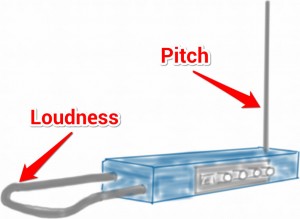Do you plan an M2M device with embedded antennas? You plan your own people, asset or pet tracker? You are aware that metal will short-cut the radio wave and will use a plastic enclosure? Plastic will not interfere? Sorry, but you are wrong. Everything in the near of your antennas will interfere.
The best example is the musical instrument called Theremin. The Theremin has two antennas. One is for controlling the loudness and the other is for the pitch. The body of the artist is already a part of the electromagnetic field. The artist has to stand still and only the fingers close to the antennas will be used to change the tone and loudness. Exactly the same will happen with the antennas of your M2M device. The plastic enclosure close to the antennas will interfere, the thickness of the plastic will interfere and even the thickness of the PCB will interfere. The resonate frequency of an antenna tested and tuned in free field will jump slightly higher as soon the same antenna will be assembled in a plastic box. Your GPS or 2400 MHz antennas (Bluetooth, WIFI/WLAN, ZigBee, ANT+) will be detuned. Their resonate frequency in free space is less than the resonate frequency you would like to receive inside the box. The GPS or 2400 MHz antennas often can be ordered in several steps of 2 MHz for away from center frequency 0f the band.
With GSM or other cellular chip antenna this is not possible. This type of antenna will often tuned by components in the matching circuit. You can shift the frequency by selecting and changing the components on the PCB. The exceptions are PCB tracks inside your PCB. Such antennas you can tune by changing the length of the radiator. There are further options for optimisation, but this short article cannot describe all.
Take care on the thickness of the PCB. 0.8 mm or 1.6 mm are the standard values. If the antenna is tested on 0,8 mm then the effect on 1,6 mm will be the same than plastic enclosure close to the antenna. The resonate frequency will jump.
The Epsilon R of air is 1. The Epsilon R of plastic is in the near or 3 and the Epsilon R of FR4 is nominal 4.2. If the radio wave will move from air in another material, the wavelength will change. The enclosure and the material of the PCB will interfere with the antenna. All other parts close by will interfere as well. Metal in the near will decrease the radio wave and will deform the antenna pattern tested in free field as well. The battery and the display are often big metal parts in a M2M device.
We hope that this few lines will assist you and help you to design a proper working M2M device. If you are still not sure what to do or if you already run in trouble, then it is highly recommended to ask for advice by a third party with skills in radio technology.
-
Nothing will interfere your embedded antenna?
-
Why the embedded chip or patch antennas are resonant on the wrong – to high – frequency?
-
How will the ground plane effect your embedded antenna?
-
Which radio approvals has your M2M device to pass?
-
How to connect your embedded antenna with your wireless module?
-
How to design an antenna matching circuit?
-
How to switch between an internal and external cellular or GNSS antenna cheap?
-
Which GPS antenna shall be used for a tracking device?
-
Which embedded antenna to select for a Bluetooth / GNSS application?
-
Dos and don’ts during embedded antenna design in
-
Examples for good and bad M2M designs with embedded antennas
- Q&A: Design in of embedded antennas

Good basic article about antenna and behavior with materials.
Harold: Great article. You are so right about attenuation and the frequency issues of chip antennas or even trace versions.
Bill, I always recommend to my customers to use Bluetooth or WLAN modules without antenna and to use a separated chip antenna or PCB trace antenna. How to optimise the antenna or matching circuit if it is already a part of the RF module? It is impossible. You loose performance and RF range or the RF module has to transmit on a higher power level. A higher power level will discharge your battery faster.
Harald, The processes you are describing are being lost by design engineers who rely more on ‘simulations’ rather than ‘hands-on’ experience. As a young RF/Antenna engineer, I was always taught to do all my portable device designs with the package in mind. I always had a prototype enclosure to place antennas & electronics into to get a feel for the real world performance of the device. Sadly, these insights are being lost by ‘kids’ who rely more on a computer than bench experience.
Brian, an evaluation kit for a GSM / UMTS antenna always comes without enclosure. Here is an example:
http://www.gsm-modem.de/gsm-pifa.html
My customers copy in first step the matching circuit from the evaluation kit. In second step I use the service of RF engineers with experience and skills to use a network analyser. This is manual work and simulation skills does not help. A simulation is fine if you start an own antenna design from scratch. After simulation comes manual work again. I assume you know that already better than me.
My article (part 1 and further) just shall help people with non or less RF skills the basic fast. I do not plan that to educate all my customers and readers of the blog to high skilled RF engineers. This is a job of the universities